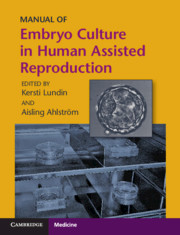Book contents
- Manual of Embryo Culture in Human Assisted Reproduction
- Cambridge Laboratory Manuals in Assisted Reproductive Technology
- Manual of Embryo Culture in Human Assisted Reproduction
- Copyright page
- Contents
- Contributors
- Preface
- Chapter 1 Facilities for Embryo Culture
- Chapter 2 Incubators for Embryo Culture
- Chapter 3 Consumables for the IVF Laboratory
- Chapter 4 Embryo Metabolism and What Does the Embryo Need?
- Chapter 5 Culture Media and Embryo Culture
- Chapter 6 Optimal Handling Techniques for Culture of Human Embryos
- Chapter 7 From Identification to Witnessing
- Chapter 8 Timing of Embryo Culture
- Chapter 9 Time-Lapse Technology
- Chapter 10 Laboratory Monitoring for Embryo Culture
- Chapter 11 Embryo Culture and IVF Offspring Outcome
- Chapter 12 The Changing Culture of Embryo Culture
- Index
- Plate Section (PDF Only)
- References
Chapter 11 - Embryo Culture and IVF Offspring Outcome
Published online by Cambridge University Press: 15 April 2021
- Manual of Embryo Culture in Human Assisted Reproduction
- Cambridge Laboratory Manuals in Assisted Reproductive Technology
- Manual of Embryo Culture in Human Assisted Reproduction
- Copyright page
- Contents
- Contributors
- Preface
- Chapter 1 Facilities for Embryo Culture
- Chapter 2 Incubators for Embryo Culture
- Chapter 3 Consumables for the IVF Laboratory
- Chapter 4 Embryo Metabolism and What Does the Embryo Need?
- Chapter 5 Culture Media and Embryo Culture
- Chapter 6 Optimal Handling Techniques for Culture of Human Embryos
- Chapter 7 From Identification to Witnessing
- Chapter 8 Timing of Embryo Culture
- Chapter 9 Time-Lapse Technology
- Chapter 10 Laboratory Monitoring for Embryo Culture
- Chapter 11 Embryo Culture and IVF Offspring Outcome
- Chapter 12 The Changing Culture of Embryo Culture
- Index
- Plate Section (PDF Only)
- References
Summary
Since the birth of Louise Brown, the first ‘test tube baby’, in 1978, assisted reproductive technology (ART) has become one of the standard treatments for couples with subfertility problems. Today, it is estimated that 8 million children have been born via ART worldwide and up to 6% of newborns in Europe are conceived via this technique (Adamson et al., 2019). Surprisingly, relatively little is known about the short- and especially long-term effects of ART manipulations on the health risks for the children.
- Type
- Chapter
- Information
- Manual of Embryo Culture in Human Assisted Reproduction , pp. 92 - 100Publisher: Cambridge University PressPrint publication year: 2021



